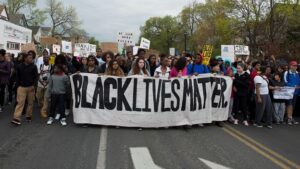 What will it take to bring about real change in racial equity in the United States? Decades of efforts to close the wealth, health, and other gaps for Black and brown Americans have not made much of a difference. In an article written by Earl Fitzhugh, J. P. Julien, Nick Noel, and Shelley Stewart for McKinsey Quarterly, the authors suggest a strategy based on new research that could bring about lasting change.
What will it take to bring about real change in racial equity in the United States? Decades of efforts to close the wealth, health, and other gaps for Black and brown Americans have not made much of a difference. In an article written by Earl Fitzhugh, J. P. Julien, Nick Noel, and Shelley Stewart for McKinsey Quarterly, the authors suggest a strategy based on new research that could bring about lasting change.
We are at a particular moment in time when ending racial inequality might be possible. The year 2020 was full of losses for Black lives that the whole world noticed:
- Murders by police of George Floyd, Breonna Taylor, and so many other people of color in the United States and other countries brought people into the streets in sixty countries and more than two thousand US towns and cities to support Black lives.
- COVID-19 deaths for Black Americans was at least double compared to white Americans.
- The economic burden of the pandemic fell significantly more heavily on Black and brown workers and business owners.
Since George Floyd was murdered in May 2020, organizations and businesses have committed more than $200 billion to address racial inequality. But, the authors note, the events above are rooted in long-standing inequities and a long history of systemic discrimination. They point out that decades of efforts to close the wealth, health, and other gaps for Black Americans have not worked:
- The racial wealth gap has persisted and grown. One study cited by the authors found that since 1950, there has been no progress toward income or wealth equality between Black and white households in the United States.
- Public, private, and social sector efforts to combat racial inequality have not had the intended impact. Each sector has systemic barriers for Black Americans built into it, and no one sector can address these barriers alone. For example, social sector organizations, such as nonprofits, cannot get adequate funding for racial justice initiatives.
The authors declare that “single-sector solutions cannot fully address the barriers to Black advancement.”
They also argue that commitments by individual organizations to combat racism will not be enough. They point out “the best hope lies with a sector-spanning coalition.” The researchers studied coalitions that successfully addressed similar complex challenges, such as discrimination against LBGTQ+ Americans and youth unemployment. Through in-depth interviews and wide-ranging conversations, which took into account the expertise, insights, and lived experiences of the leaders of these successful coalitions, they found five attributes that could be the foundation of an intervention that eliminates structural racism in the United States. The five attributes of successful coalitions from this research are
- Unite around one clear mission—The authors note that “racial inequalities exist in nearly every area of society—housing, politics, finance, labor, criminal justice, and more.” It can be difficult for different sectors to all agree on one mission, but that is essential. For example, the LGBTQ+ organizations agreed on Freedom to Marry, which aimed to win the right for same-sex couples to marry, as the goal they would unite around, even though many organizations had other agendas. They were able to organize a critical mass of people, supporters, resources, and momentum to accomplish their goal.
- Coordinate and collaborate via a central backbone—Successful coalitions rely on a backbone structure—a core group that provides national coordination to convene stakeholders, build consensus, coordinate action, collect and disseminate data, track overall progress, and publicize the results.
- Secure adequate and appropriate funding—The authors note that “Black-led and Black-focused organizations are disproportionately underfunded.” Smaller grants, restricted grants, and unconscious bias in funding decisions limit the ability of Black-led organizations to accomplish their goals. Successful coalitions have a large group of funders willing to pool resources and leave allocation decisions to a strong leader.
- Ensure accountability—Successful coalitions have systems in place to collect, analyze, and share data on outputs and outcomes of their initiatives and agree on measures of success.
- Win and maintain support from a broad set of stakeholders—They encourage active engagement from institutions and individuals beyond those directly affected.
These five attributes of successful coalitions make so much sense as components of a strategy to eliminate racial inequality for Black and brown people as well as for other complex social issues. Stacey Abrams implemented a similar strategy for turning Georgia into a blue state. Fragmentation is the killer of dreams, but coalitions can make big change happen.
Photo courtesy of Fibonacci Blue (CC BY 2.0)